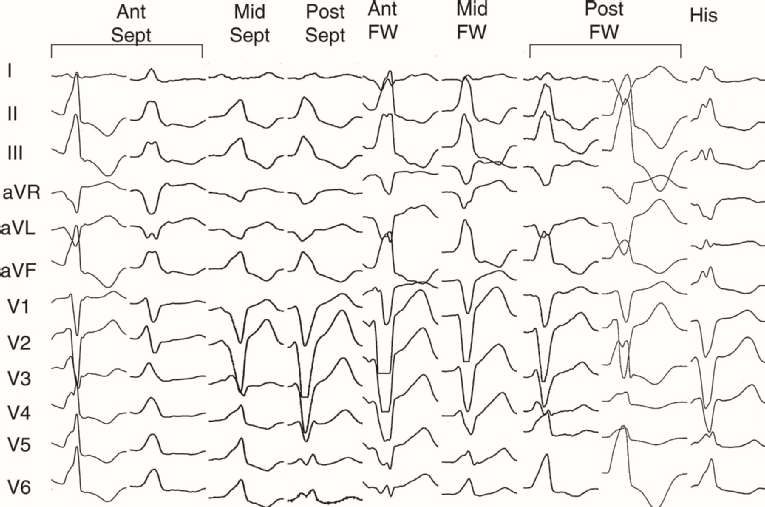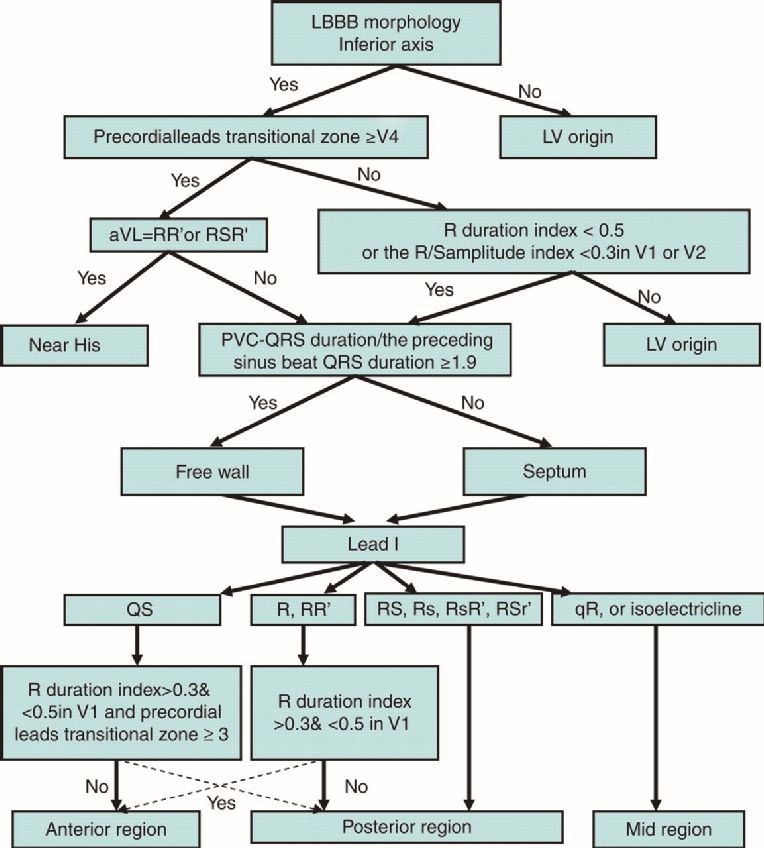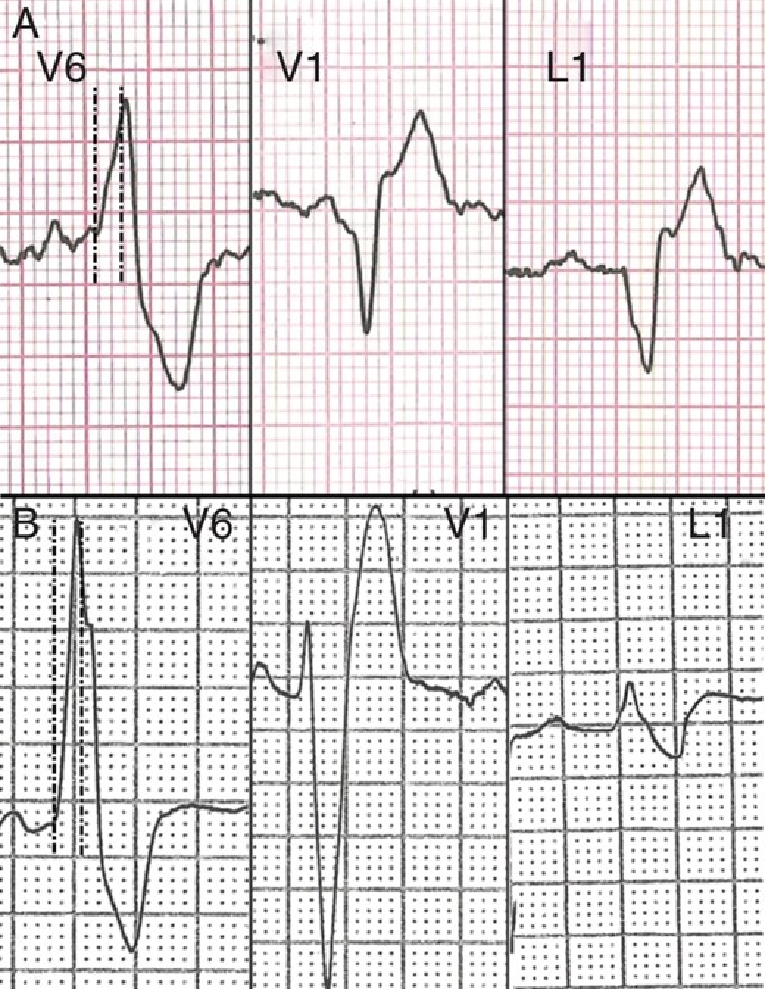Topics: athletes, premature ventricular beats, arrhythmia, sudden cardiac death
Background
Frequent and complex premature ventricular beats (PVBs) detected during the cardiovascular screening of the athletic population may be a sign of an underlying cardiovascular disease causing the risk of sudden cardiac death (SCD) but are also often recorded in trained athletes without cardiovascular abnormalities. The interpretation of PVBs could represent a clinical dilemma in the general population and particularly in athletes. The initial evaluation should be to use an algorithmic approach for risk stratification.
However, while certain characteristics of PVBs are considered common and benign, others occur uncommonly in athletes raising the suspicion of underlying cardiovascular disease. The evaluation of these should begin with a complete clinical history, symptoms on exercise, family history, race and ethnic origin of the athletes and their families, origin of regions with endemic diseases that may predispose to cardiac disease, arrhythmias and sudden cardiac death (SCD), use of substances to improve sports performance or recreational drugs, and comorbidities. This is the initial step to suspect that these can lead to complex arrhythmias and SCD in the athlete.
The physical examination helps to identify associated cardiac and non-cardiac conditions, in which the finding of PVBs can lead to the suspicion of associated diseases and the risk of SCD.
Interpretation of multiple premature ventricular contractions
Multiple (≥2) PVBs are uncommon and present in <2.1% to 1.1%, and polymorphic PVBs only in 0.1% of 12-lead ECGs in athletes [1,2]. Intervals of a continuous 10 seconds when performing the ECG recording for rhythm analysis are seen. The same is observed in the standard tracings obtained with digital electrocardiographs which should provide accurate temporal alignment of multiple leads [3]. Common sites of PVBs include the right (RVOT) and left ventricular outflow tracts (LVOT), the mitral annulus, and the aortic cusps. In addition, the right ventricular septum in the vicinity of the His bundle has been reported to be a site of idiopathic PVBs. Although they are usually benign, their presence may be the hallmark of underlying heart disease [4,5]. The most common dilemma is with the PVBs originating from the RVOT (left bundle branch block [LBBB] morphology and inferior axis): this is the most common site of origin for ventricular arrhythmias that occur in the absence of structural heart disease [6]. Figure 1 shows representative ECG examples of PVBs originating from different sites at the RVOT [7].
Figure 1. Representative 12-lead electrocardiograms of premature ventricular complex originating from anterior septum (A), mid septum (B), posterior septum (C), anterior free wall (D), mid free wall (E), posterior wall (F), near His bundle region (G), and anterior septum (H) of the right ventricular outflow tract. Reproduced with permission from Zhang et al [7].

While considered particularly benign when associated with a normal ECG, this PVB morphology can also be present in patients with early arrhythmogenic right ventricular cardiomyopathy (ARVC), particularly when the QRS exceeds 160 ms and there is left bundle branch morphology with a superior axis (negative or indeterminate QRS in leads II, III, and if the aVL lead is positive) [6,7,8]. The ECG algorithm is proposed for PVBs originating in the RVOT [7]. See Figure 2.
Figure 2. Stepwise electrocardiographic algorithm for determination of the location of the origin of a premature ventricular complex from the right ventricular outflow tract. Reproduced with permission from Zhang et al [7].

LBBB: left bundle branch block; LV: left ventricular; near His: near the bundle of His region; RV: right ventricular; TZI: transitional zone index
However, according to the analysis proposed by Novak et al [9], genetically affected patients with early ARVC phenotypic expression may show PVBs with an LBBB morphology with inferior axis configuration and none, or only minor abnormalities on ECG and echocardiography, thus mimicking idiopathic RVOT arrhythmias. The morphology of the QRS in these two conditions may help differential diagnosis, and features such as ectopic QRS axis >90° (negative QRS polarity in lead 1), intrinsicoid deflection time >80 ms, and QS morphology in lead V1, particularly when present in combination, should raise hightened clinical suspicion of an underlying cardiomyopathy. The combination of all three criteria demonstrate a sensitivity of 55% (95% CI: 32-78), a specificity of 91% (95% CI: 76-98), a positive predictive value of 79% (95% CI: 49-95), and a negative predictive value of 77% (95% CI: 61-89) [9]. Figure 3.
Figure 3. Representative example of ECG leads V6, V1, and 1 in a patient with early ARVC (A) and in a patient with idiopathic RVOT arrhythmia (B). In lead V6, the dotted lines identified an 80 ms interval after the beginning of the QRS. The intrinsicoid deflection time is >80 ms in the early ARVC patient, whereas it is ≤80 ms in the patient with idiopathic RVOT arrhythmia. In lead V1, there is a QS morphology in the early ARVC patient but not in the idiopathic RVOT arrhythmia patient. In lead 1, a Q-wave is observed only in the early ARVC patient. The co-existence of all three factors has a sensitivity of 55% and a specificity of 91% for early ARVC. Reproduced with permission from Novak et al [9].

Therefore, the finding of ≥2 PVCs in 10 second record ECG should prompt more extensive evaluation to exclude underlying structural heart disease [10].
If ventricular arrhythmias are seen, the evaluation should include a thorough family history, an echocardiogram to evaluate for structural heart disease, cardiac magnetic resonance imaging (MRI) to assess for ARVC or other cardiomyopathies, an ambulatory ECG monitor and exercise ECG test. Depending on these results, further evaluation may be needed including an electrophysiology study or genetic testing [11,12].
An approach to evaluation
The evaluation of ≥2 PVBs is controversial and excluding pathologies associated or not, with risk SCD is difficult. In these cases, more tests may be necessary: ambulatory Holter monitor, echocardiogram, exercise stress test should be performed, and signal-averaged ECG can be considered [10, 11]. If these tests do not present abnormal findings and the PVBs are suppressed with exercise, no further evaluation is recommended for an asymptomatic athlete.
Different studies have shown evidence that in athletes with ≥2,000 PBVs per 24 hours, up to 30% of these were found to have underlying structural heart disease as compared with the finding of 3% and 0% in athletes with <2,000 and <100 PVCs per day, respectively. For this reason, additional tests are necessary in athletes with ≥2,000 PBCs per 24 hours, or the finding of episodes of non-sustained ventricular tachycardia, or evidence of an increasing burden of PVBs during an exercise test. These additional evaluations include contrast-enhanced cardiac MRI and more invasive electrophysiology study [13,14].
The proscription of physical activity for diagnostic or therapeutic considerations, that is, with detraining, are contradictory. [15]. Because of this, the presence of a single PVB in athletes ≥25 years of age and presenting PVB with LBBB morphology and superior axis, may lead to suspicion of myocardiopathy and further studies are necessary [10].
Novak et al, as well as others in the current literature recommend, "if ventricular arrhythmias are seen, the evaluation should include a thorough family history, an echocardiogram to rule out structural heart disease, cardiac MRI for diagnosis of ARVC or other cardiomyopathies, ambulatory ECG monitor and exercise ECG test.” According to the result of these, further evaluation may be needed including electrophysiology study and genetic testing [5,10,11,12].
Pathological findings associated with pvbs
Multiple premature PVBs are also associated with hypertrophic cardiomyopathy, dilated cardiomyopathy, left ventricular non-compaction, arrhythmogenic right ventricular cardiomyopathy, myocarditis, sarcoidosis, congenital coronary anomalies, Brugada syndrome and other channelopathies (electrical primary disease). The related entities have abnormal findings in the electrocardiogram and in other studies, in addition to the occasional finding of PVBs. If >2000 PVCs or non-ventricular tachycardia are present on initial testing, a complete cardiac evaluation should be considered, including MRI, to rule out myocardial and primary electrical disease [16].
Special conditions associated with sudden cardiac death
Mitral valve prolapse
Mitral valve prolapse (MVP) has been associated with SCD. Patients diagnosed with MVP and with ventricular arrhythmias are at risk of SCD, often seen to be young adult women with a finding of mild systolic click at auscultation, bileaflet involvement of the mitral valve, T-wave abnormalities on the inferior leads, and PVBs with right bundle branch block (RBBB) morphology and ventricular arrhythmias or polymorphic ventricular arrhythmias on ECG. The finding of fibrosis of the papillary muscles and inferobasal left ventricular wall correlates with the presence of myocardial fibrosis with ventricular arrhythmias originating in these regions with arrhythmia and its morphology, due to stretching by the prolapsing leaflets and their relationship with the elongated chordae [17,18].
Premature ventricular beat-induced cardiomyopathy
Over the last decade, PVC-induced cardiomyopathy has been a subject of great interest. PVBs in patients with presumed idiopathic dilated cardiomyopathy subsequently demonstrated improved left ventricular systolic dysfunction when the PVNs decreased. The frequency of PVBs correlates at least modestly with the extent of left ventricular dysfunction and ventricular dilation in the absence of structural heart disease [19].
Catecholaminergic polymorphic ventricular tachycardia
Catecholaminergic polymorphic ventricular tachycardia (CPVT) is a cardiac conduction disorder whereby changes in intracellular calcium regulation increase susceptibility to ventricular arrhythmias with a consequent risk of sudden death despite a structurally normal heart [20]. It is a rare malignant arrhythmic disorder with hereditary features characterised by exercise or emotional stress-induced ventricular arrhythmias, especially bidirectional or polymorphic ventricular tachycardia, syncope, or SCD. Patients usually have normal resting ECG. In young children, the presence of supraventricular arrhythmias can be the first expression of the occurrence of the classic CPVT phenotype. These can be seen in a structurally normal heart with normal ECG, and unexplained exercise symptoms or catecholamine induced bidirectional ventricular tachycardia (VT) or polymorphic VPBs or VT in an individual <40 years and / or in carriers of a pathogenic mutation in a CPVT associated gene. Exercise testing has a specificity of 97% and a sensitivity of 50%. Holter monitoring is useful to detect the presence of supraventricular arrhythmias but is less sensitive than exercise testing. Genetic testing confirms the diagnosis [21].
Presence of ventricular arrhythmias
The finding of ventricular couplets, triplets, and non-ventricular tachycardia is essential for further investigation. These can be a marker for underlying cardiac pathology. Preceding the occurrence of ventricular tachycardia sustained which increases the risk of SCD. [22,23,24]
Considerations in athlete’s ≥30 years of age
In athletes ≥30 years of age, CAD is the most common cause of SCD. In addition, older athletes may be less fit compared with 20 to 30 years ago, increasing the possibility of underlying CAD. While resting ECGs have a low sensitivity for CAD, some ECG patterns may suggest underlying CAD such as TWI, pathological Q waves, ST-segment depression, left or RBBB, abnormal R-wave progression, left anterior hemiblock, and atrial fibrillation [10, 24].
Evaluation of PVCs in athlete’s ≥30 years of age
The main role of a resting ECG in older athletes is to identify those athletes who may potentially be at high risk for CAD and warrant further testing. Initial evaluation includes traditional risk factors for CAD and tests should be performed such as an ECG, exercise stress test, echocardiogram. When indicated, this evaluation may be complemented by Coronary computed tomography angiography (CCTA) or a functional stress test [23,24].
Atrial tachyarrhythmias
Findings such as ectopic atrial rhythm with P-waves are a different morphology compared with the sinus P-wave, e.g., negative P-waves in the inferior leads (low atrial rhythm), or when the junctional escape rhythm QRS rate is faster than the resting P-wave or sinus rate and typically <100 beats/min with narrow QRS complex unless the baseline QRS is conducted with aberrancy, are considered normal findings in athletes and no additional studies should be done.
As described by K.V. Lieve et al, "If resting sinus tachycardia (>120 beats/min) is seen, the first step is to repeat the ECG in other conditions." Discarding clinical conditions associated with cardiomyopathies should be considered. Supraventricular tachycardia, atrial fibrillation, and atrial flutter are rarely seen on a resting ECG in athletes. This can be an expression of another condition, such as long QT Syndrome, Wolf Parkinson's White Syndrome, Brugada Syndrome, myocarditis, congenital heart disease, and the cardiomyopathies. More studies if needed include echocardiogram, ambulatory ECG monitor, and exercise treadmill test. Referral to an electrophysiologist may be indicated for consideration of electrophysiology study and ablation [22].
CONCLUSION
In an electrocardiogram at rest the presence of multiple premature PVBs are usually benign, although they may be the source of underlying heart disease such as hypertrophic cardiomyopathy, dilated cardiomyopathy, left ventricular non-compaction, arrhythmogenic right ventricular cardiomyopathy, myocarditis, sarcoidosis and congenital coronary anomalies, Brugada syndrome and another channelopathies recognised entities associated with increased risk of SCD. It is important to recognise the conditions that may be related to different pathological entities and the risk of SCD.
In the initial approach, the analysis of abnormal findings in the resting electrocardiogram is essential. The presence of PVBs analysing their morphology, their arrhythmic load and presence of complex ventricular arrhythmias. Additional studies such as echocardiogram, 24-hour ECG monitor and exercise ECG test, and Signal Averaged ECG are useful for evaluation and decision making.
Recognising these conditions and making the decision to perform studies of high complexity should be taken with caution and knowledge of the suspected pathology. If necessary, the referral to a special or specialised centre, to be evaluated in doubtful cases or lack of experience of the responsible physician.
The electrocardiogram is useful to detect the athlete at risk of SCD, but we cannot ignore that in the presence of an unexpected SCD the opportunity of saving these athletes lives, lies in the knowledge of cardiopulmonary resuscitation and the use of the external automated defibrillator.


 Our mission: To reduce the burden of cardiovascular disease.
Our mission: To reduce the burden of cardiovascular disease.